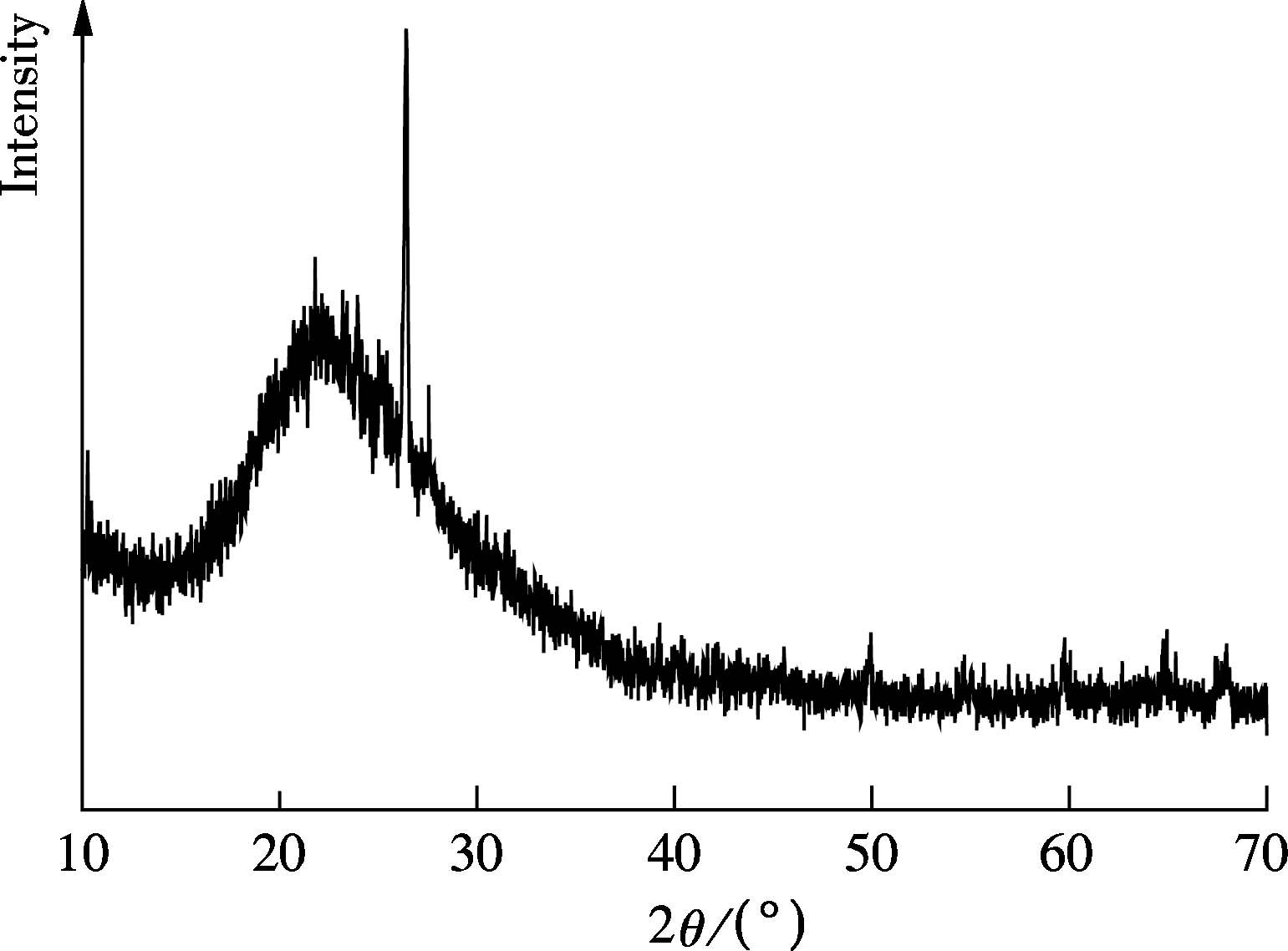
Fig.1 XRD pattern of rice husk charcoal
Abstract:The rice husk ash (RHA) and silica (SiO2) nanoparticles are prepared from rice husk charcoal (RHC) by the methods of ventilated calcining and chemical precipitation, respectively, to remove the residual carbon which is harmful to cement composites. The structures and morphologies of these products are investigated by the Fourier transform infrared spectroscopy, X-ray diffraction, scanning/transmission electron microscopy and N2 adsorption-desorption analyzer. The results show that the as-produced RHA and SiO2 nanoparticles exist in amorphous phase without residual carbon, and exhibit porous structures with specific surface areas of 170.19 and 248.67 m2/g, respectively. The micro particles of RHA are aggregated by numerous loosely packed SiO2 gel particles with the diameter of 50 to 100 nm. The SiO2 nanoparticles are well dispersed with the average size of about 30 nm. Both the RHA and SiO2 nanoparticles can significantly reduce the conductivity of saturated Ca(OH)2 solution and increase the early strength of the cement composites. They also exhibit high pozzolanic activity, indicating that they can be used as ecological nano mineral admixtures.
Key words:ecological nano mineral admixture; rice husk charcoal (RHC); rice husk ash (RHA); SiO2 nanoparticles; pozzolanic activity
The ultra-high performance concrete (UHPC) refers to the concrete with compressive strength more than 150 MPa and tensile strength more than 15 MPa. Compared with conventional concrete, UHPC requires concrete with improved performance such as high strength, high durability, low shrinkage and low abrasion, which is urgently needed in the key projects such as cross-sea bridges, subsea tunnels and marine works. Extensive research has found that the introduction of SiO2, Al2O3, Fe2O3, and TiO2 nanoparticles can effectively improve the mechanical properties and durability of cement composites[1-5]. But the massive application of nanoparticles in cement composites is limited due to their high cost and low productivity. Therefore, exploring a low-cost technique for the industrial preparation of nanomaterials is important for the application of UHPC.
Rice husks are agricultural byproducts of which major constituents are organic materials and hydrated silica. As cheap and renewable energy, the rice husk is widely used for gasification power generation, while the remaining waste becomes rice husk charcoal (RHC). RHC contains 30% to 40% residual carbon, 40% to 50% silica and minor amounts of metallic elements[6]. It is reported that the amorphous SiO2 in rice husk can promote secondary hydration with calcium hydroxide producing C-S-H with high density[7]. However, the residual porous carbon in RHC will absorb a non-negligible amount of water. Burning in air is the traditional method to remove residual carbon[8]. Temperature is the key factor for the quality of as-produced RHA. The carbon cannot be removed thoroughly due to incomplete burning at low temperature. When the temperature is high, the crystallization process will take place, leading to the decrease of activity. Chemical precipitation is another way to purify the silica from RHC. However, the precipitated silica tends to agglomerate due to the existence of hydrophilic Si-OH groups. Therefore, the removal of residual carbon without undermining the activity of SiO2 particles is the prerequisite for the preparation of ecological nano admixtures.
In this paper, approaches are developed to prepare ecological nano mineral admixtures from RHC and their pozzolanic activity is also investigated. This research provides benefit for the sustainable development of the ecology and environment.
1.1 Materials
The raw material RHC is provided by Shanghai Sennong Environmental Technology Company. Fig.1 illustrates the X-ray diffraction analysis of RHC. A broad peak around 20° to 30° is observed, which can be attributed to the presence of amorphous silica. The peak at 26° is for the graphitic structure indicating the existence of residual carbon. The chemicals used in this research are sodium hydroxide, ammonium chloride and ethyl alcohol, which are all analytical grade. Polycarboxylate superplasticizer (PC, solid content 40%) is procured from Subote New Material Co., Ltd., Nanjing, China.

Fig.1 XRD pattern of rice husk charcoal
1.2 Experimental procedures
In order to obtain highly purified ecological nano admixtures, the pretreatment process of leaching in H2SO4 acid (20%) at the temperature of 100 ℃ for 2 h was carried out.
The preparation process of ecological nano admixtures from RHC is illustrated in Fig.2. RHA was obtained by calcining the pretreated RHC at 600 ℃ for 2 h in a well-ventilated tube furnace. The chemical precipitation method included the following procedures: the pretreated RHC and NaOH solution were mixed and subjected to boiling at 100 ℃ for 2 h in a reaction still. Then the sodium silicate solution and residual carbon were separated through filtrating. Subsequently, ammonium chloride solution was added very slowly in small amounts to the flask containing sodium silicate, ethyl alcohol and PC at the temperature of 40 ℃. Meanwhile, white colloidal precipitation slowly appeared. The as-produced SiO2 was purified by water before being filtrated and dried under vacuum at 60 ℃ for 24 h.
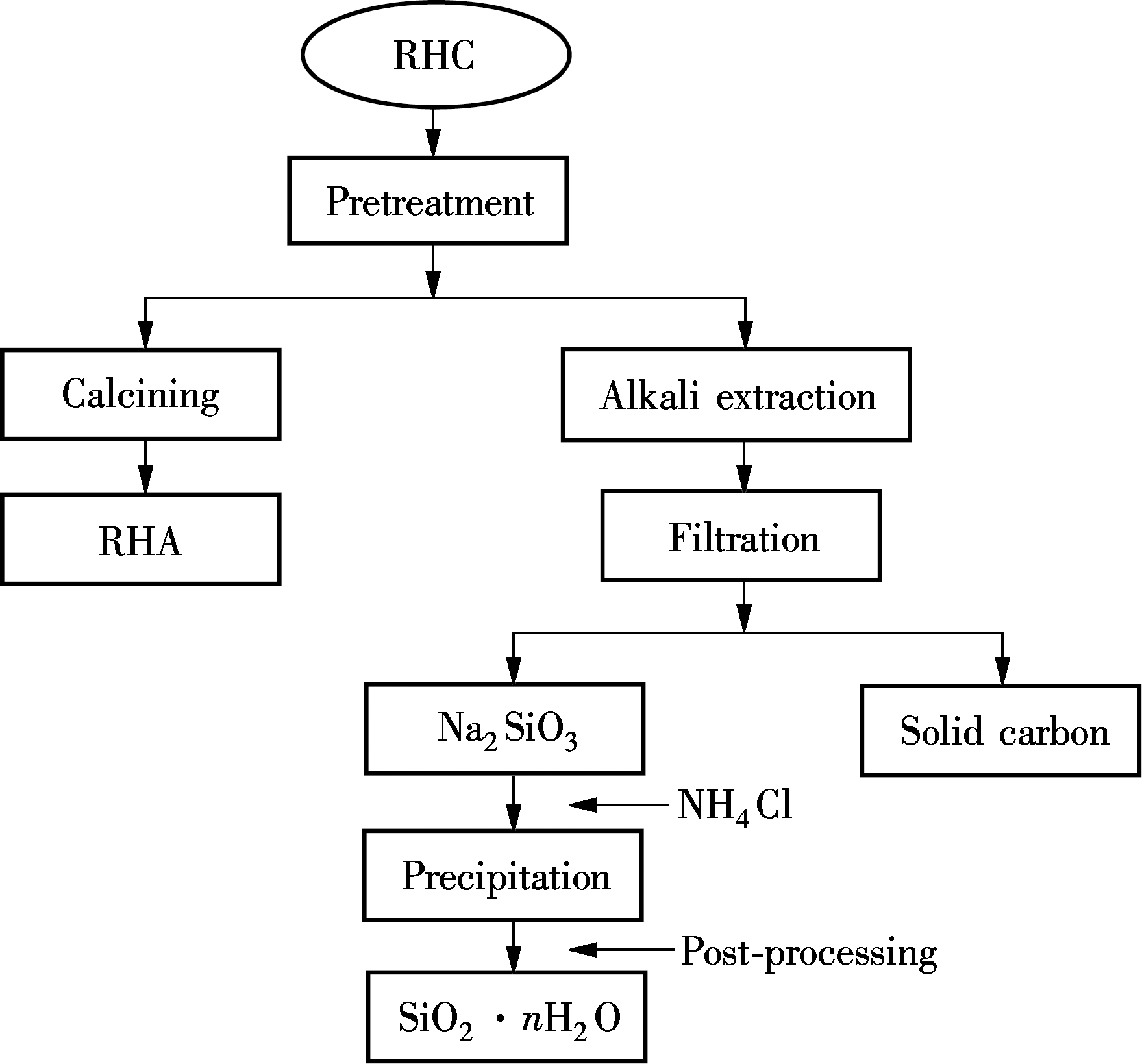
Fig.2 The preparation process for RHA and SiO2 nanoparticles
1.3 Characterization
The crystalline phase was analyzed using a X-ray diffractometer. The presence of functional groups was clearly proved by the Fourier transform infrared spectroscopy (FTIR) analysis. A transmission electron microscope (TEM) and scanning electron microscope (SEM) were utilized to visualize the morphology of samples. The specific surface areas and pore structures were characterized by a N2 adsorption-desorption analyzer.
2.1 Structure
The FTIR spectra of precipitated SiO2 and RHA are shown in Fig.3. The characteristic peak around 470 cm-1 is assigned to the bending vibration of Si—O—Si. The peaks at 807.09 and 1 043.78 cm-1 refer to the symmetric stretching and anti-symmetric stretching of Si—O, respectively. The peak for H—OH bending vibration is observed at 1 629.44 cm-1, showing the presence of absorbed water. The peak at 3 432.61 cm-1 is characteristic of the presence of O—H anti-symmetric bending vibration in OH groups. A tiny peak at 958.67 cm-1 in the spectra of precipitated SiO2 shows the presence of Si—OH groups, albeit they fail to appear in the spectra of RHA due to the conversation of silanol groups (Si—OH) to siloxane bridges (Si—O—Si) when RHC is calcined in air[9].

Fig.3 FTIR spectra of RHA and precipitated SiO2
Fig.4 shows the X-ray diffraction analysis of precipitated SiO2 and RHA. All the samples exhibit an amorphous form. A broad peak is observed between 15° and 30°, which can be attributed to the presence of disordered cristobalite. The disappearance of the peak at 26° as shown in Fig.1 demonstrates that the residual carbon has been removed. A low temperature (600 ℃) is sufficient to oxidize the residual carbon completely during ventilated calcining, which is advantageous for saving energy and protecting activity.

Fig.4 XRD patterns of RHA and precipitated SiO2
2.2 Morphology
The SEM images of RHA at different magnifications are shown in Fig.5. The microstructure of as-produced RHA is coincident with the three-layer model (The 1st layer: 1 μm to 1 mm; the 2nd layer: 0.05 to 1 μm; the 3rd layer: <50 nm) proposed by Ouyang et al.[10]. It is observed that the 2nd layer of RHA particles are aggregated of numerous loosely packed SiO2 gel particles with the diameter of 50 to 100 nm, leaving considerable nanopores, which are in favour of increasing specific surface area and pozzolanic activity.
Dispersion of precipitated SiO2 nanoparticles is crucial to fulfill their function as an active admixture for cement composites. However, dispersion of them is very difficult due to the large surface areas. In this research, PC was used to improve dispersion of SiO2 by creating a layer of common charge over particles and also by reducing the surface energy. Moreover, as the precipitant, NH4Cl slowly releases H+ in case of the agglomeration of SiO2 nanoparticles.
TEM images of as-produced SiO2 nanoparticles at different magnifications are shown in Fig.6. The diameter of SiO2 nanoparticles is about 30 nm, lower than that of 50 to 100 nm reported in Ref.[11]. The SiO2 nanoparticles are well dispersed without sever agglomerates.
2.3 Specific surface area and pore structure
Tab.1 summarizes the results of specific surface areas and pore structures of RHA, SiO2 nanoparticles and silica fume (SF). The statistics of the pore volume exhibit that the as-produced RHA and SiO2 nanoparticles are highly porous materials in accordance with the morphology analysis in section 2.2. The specific surface area of RHA is 170.19 m2/g, which is much higher than that of 50 to 100 m2/g reported by Ouyang et al.[10]. Meanwhile, the surface area of SF is 53.30 m2/g, which is mainly due to the aggregation of fine particles. For SiO2 nanoparticles, the nano-sized SiO2 particles with well dispersion contribute to the high surface area of 248.67 m2/g.
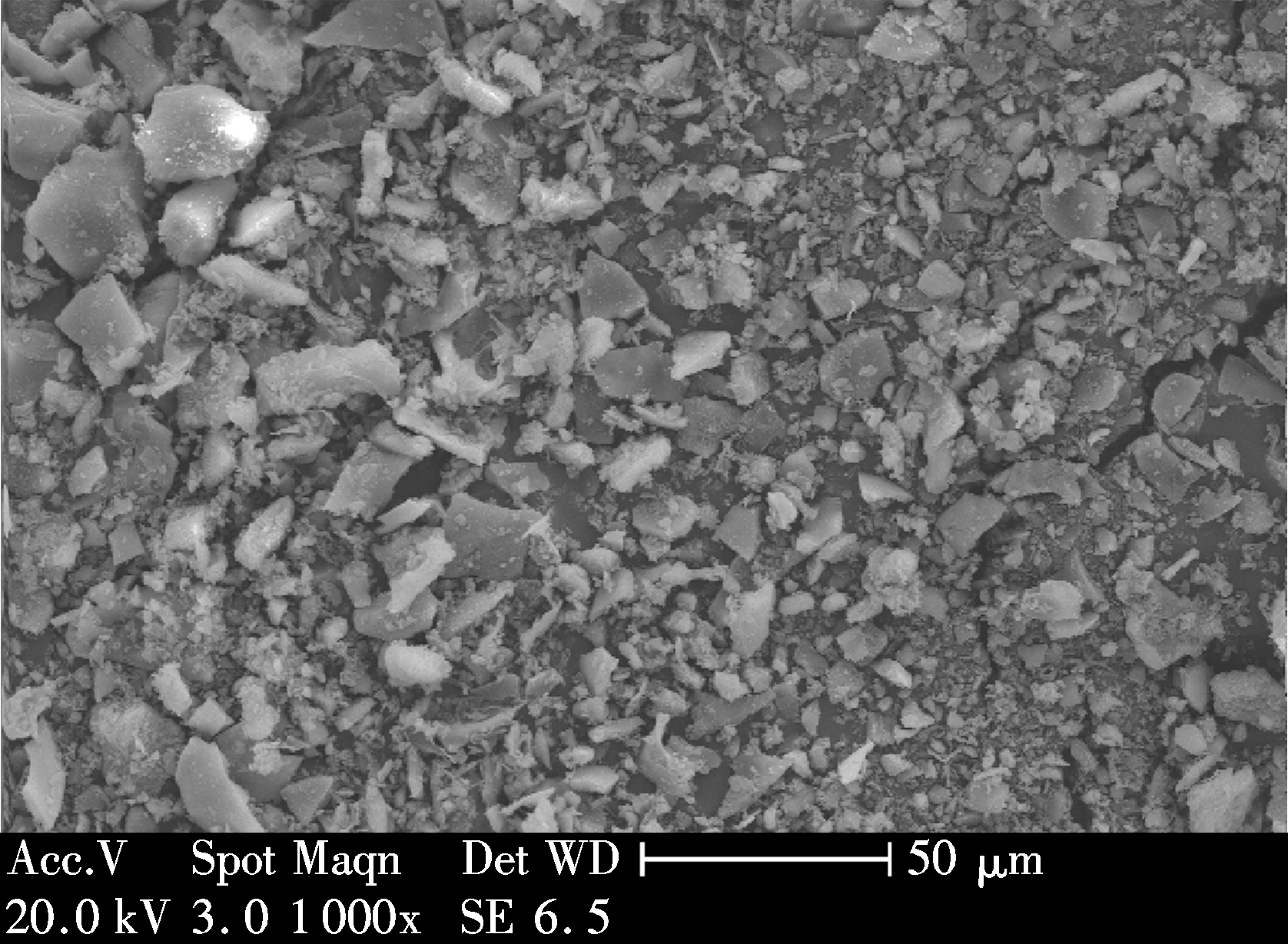
(a)
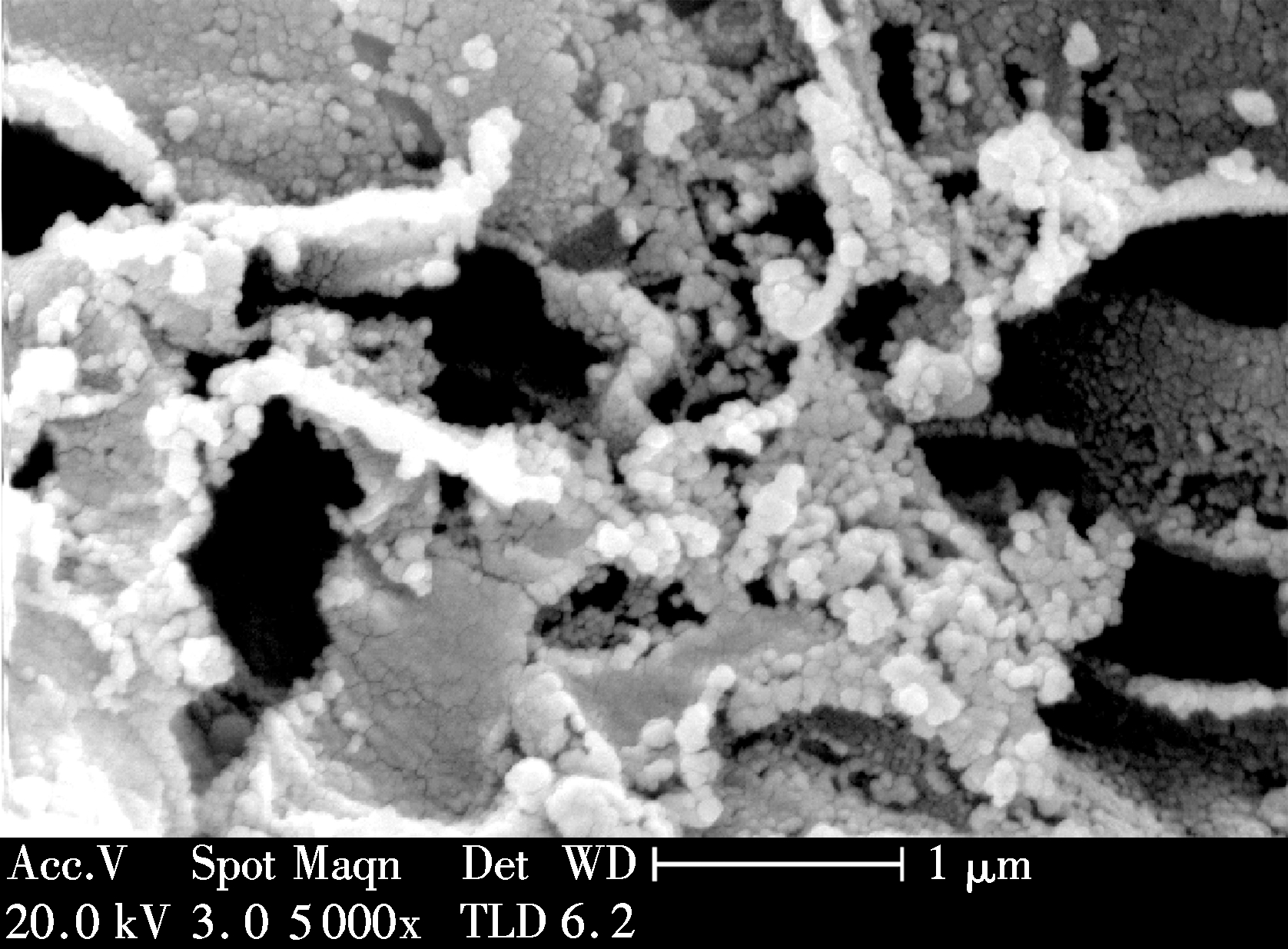
(b)

(c)

(d)Fig.5 SEM images of RHA at different magnifications.
(a) ×1 000; (b) ×5 000; (c) ×10 000; (d) ×20 000

(a)
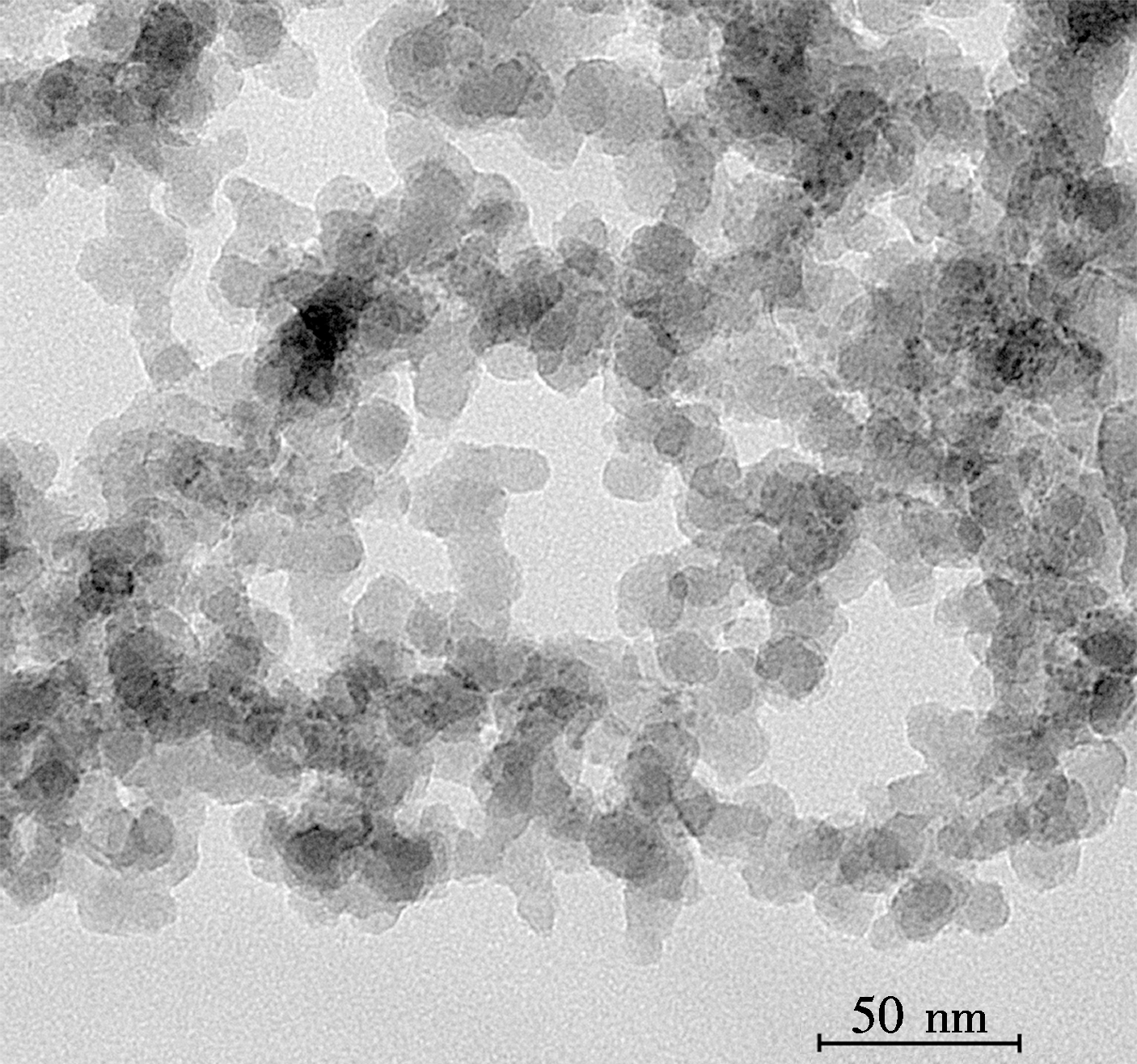
(b)Fig.6 TEM images of precipitated SiO2. (a) At low magnification; (b) At high magnification
Tab.1 The specific surface areas and pore structures of RHA, SiO2 nanoparticles and SF

SampleSpecificsurfacearea/(m2·g-1)Totalporevolume/(mL·g-1)Maximumporevolume/nmRHA170.190.269361.7SiO2248.670.323418.0SF53.300.102339.6
2.4 Pozzolanic activity
Conductivity tests[12] were carried out to investigate the pozzolanic activity of as-produced RHA and SiO2 nanop-
articles with SF as reference. The particles with pozzolanic activity will hydrate with Ca2+ leading to a lowering of the conductivity of the saturated Ca(OH)2 solution. Therefore, the difference of conductivity (ΔE) can be measured as the pozzolanic activity of particles. Test results are plotted in Fig.7. The activity of RHA and SiO2 nanoparticles is superior to that of SF encompassing all ages. The high specific surface areas of SiO2 nanoparticles and RHA can promote chemical reactivities and accelerate nucleation growth[13]. In the early stages, the activity of SiO2 nanoparticles is slightly lower than that of RHA. This is because the hydration reactions are temporarily retarded by PC.
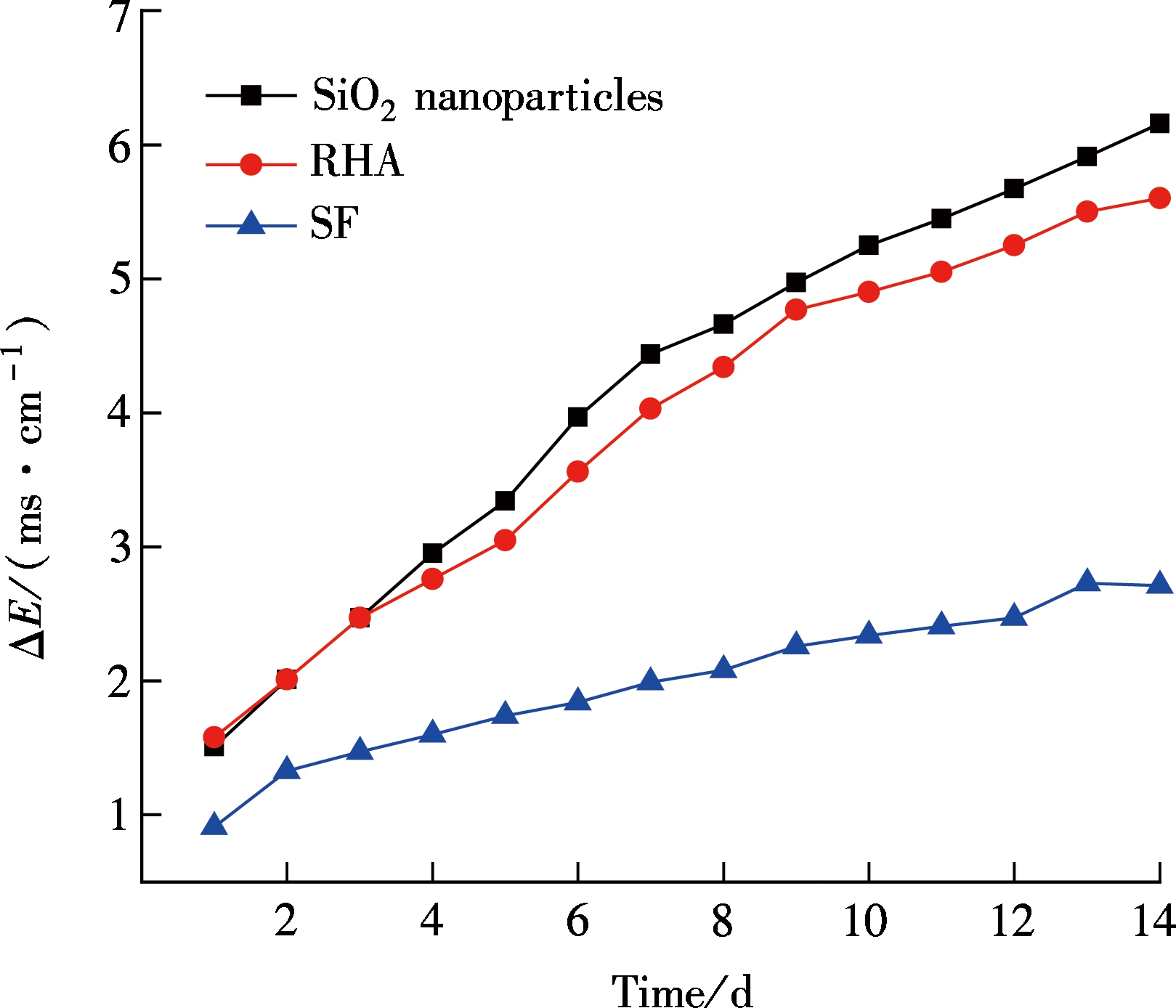
Fig.7 Influences of RHA, SiO2 nanoparticles and SF on the conductivity of Ca(OH)2solution
The effects of as-produced RHA and SiO2 nanoparticles on the mechanical performance of cement composites were also characterized. PI 52.5R cement and China ISO standard sand were used in this experiment. The details of the mix design and compressive strengths of the test specimens are shown in Tab.2. The strengths of cement composites incorporating RHA and/or SiO2 nanoparticles outperform their plain-cement counterparts at all ages. The results indicate that the addition of RHA and/or SiO2 nanoparticles with high pozzolanic activity has a positive impact on the process of hydration, which directly transforms into mechanical properties.
Tab.2 The reinforcement of RHA and nano-SiO2 in early strength of cement composites

Samplemwater/mcrementmsand/mcementw(RHA)/%w(SiO2)/%w(PC)/%Compressivestrength/MPa1d3d7dPlaincement0.423000.1127.6642.5852.81RHAcement0.423100.4031.2348.6958.46Nano-SiO2cement0.423010.4830.5650.4559.71Compoundcement0.423110.7731.8954.5263.77
1) The as-produced RHA and SiO2 nanoparticles exist in an amorphous phase without residual carbon.
2) The micro particles of RHA are composed of numerous loosely packed SiO2 gel particles with the diameter of 50 to 100 nm. The SiO2 nanoparticles are well dispersed with the average size of about 30 nm.
3) RHA and SiO2 nanoparticles exhibit porous structures with large specific surface areas of 170.19 and 248.67 m2/g, respectively.
4) Both the RHA and SiO2 nanoparticles exhibit high pozzolanic activity, indicating that they can be used as ecological nano mineral admixtures.
References:
[1]Nazari A, Riahi S. Abrasion resistance of concrete containing SiO2 and Al2O3 nanoparticles in different curing media [J]. Energy and Buildings, 2011, 43(10): 2939-2946. DOI:10.1016/j.enbuild.2011.07.022.
[2]Khoshakhlagh A, Nazari A, Khalaj G. Effects of Fe2O3 nanoparticles on water permeability and strength assessments of high strength self-compacting concrete [J]. Journal of Materials Science and Technology, 2012, 28(1): 73-82. DOI:10.1016/S1005-0302(12)60026-7.
[3]Nazari A, Riahi S. Prediction split tensile strength and water permeability of high strength concrete containing TiO2 nanoparticles by artificial neural network and genetic programming [J]. Composites: Part B, 2011, 42(3): 473-488. DOI:10.1016/j.compositesb.2010.12.004.
[4]Pacheco-Torgal F, Miraldo S, Ding Y, et al. Targeting HPC with the help of nanoparticles: An overview [J]. Construction and Building Materials, 2013, 38: 365-370. DOI:10.1016/j.conbuildmat.2012.08.013.
[5]Yu R, Spiesz P, Brouwers H J H. Effect of nano-silica on the hydration and microstructure development of ultra-high performance concrete (UHPC) with a low binder amount [J]. Construction and Building Materials, 2014, 65: 140-150. DOI:10.1016/j.conbuildmat.2014.04.063.
[6]Fang Fang, Zhou Jianbin, Yang Jiliang. Poly-generation of activated carbon and silica from rice husk charcoal [J]. Transaction of the Chinese Society of Agricultural Engineering, 2012, 28(23): 184-191. (in Chinese)
[7]Jauberthie R, Rendell F, Tamba S. et al. Origin of the pozzolanic effect of rice husks [J]. Construction and Building Materials, 2000, 14(8): 419-423. DOI:10.1016/s0950-0618(00)00045-3.
[8]Khan R, Jabbar A, Ahmad I, et al. Reduction in environmental problems using rice-husk ash in concrete [J]. Construction and Building Materials, 2012, 30: 360-365. DOI:10.1016/j.conbuildmat.2011.11.028.
[9]Liou T H. Preparation and characterization of nano-structure silica from rice husk [J]. Materials Science & Engineering A, 2004, 364(1): 313-323. DOI:10.1016/j.msea.2003.08.045.
[10]Ouyang Dong, Chen Kai. SEM/TEM study on the microstructure of rice husk ash and nano-SiO2 in it [J]. Journal of Chinese Electron Microscopy Society, 2003, 22(5): 390-394. (in Chinese)
[11]Zheng Dianmo, Zhang Xiaojie, Liu Xiaomei. New technology for preparation of nano-sized silica from rice husk [J]. Inorganic Chemicals Industry, 2010, 42(12): 52-54. (in Chinese)
[12]Luxan M P, Madruga M, Saavedra J. Rapid evaluation of pozzolanic activity of natural products by conductivity measurement [J]. Cement and Concrete Research, 1989, 19(1): 63-68. DOI:10.1016/0008-8846(89)90066-5.
[13]Jamil M, Kaish A B M A, Raman S N, et al. Pozzolanic contribution of rice husk ash in cementitious system [J]. Construction and Building Materials, 2013, 47: 588-593. DOI:10.1016/j.conbuildmat.2013.05.088.
Citation:Zhao Li, Guo Xinli, Ge Chuang, et al. Preparation and activity research of ecological nano mineral admixture from rice husk charcoal[J].Journal of Southeast University (English Edition),2016,32(3):368-372.DOI:10.3969/j.issn.1003-7985.2016.03.018.
DOI:10.3969/j.issn.1003-7985.2016.03.018
摘要:为了去除稻壳炭中对水泥基材料有害的残留炭,分别采用通风煅烧和化学沉淀的方法得到稻壳灰(RHA)和纳米SiO2; 采用红外、X射线衍射、扫描/透射电子显微镜和氮吸附-脱附研究了2种产物的结构和形貌.结果表明:RHA和纳米SiO2均为无定形结构,残留炭已基本去除;它们呈多孔结构,比表面积分别为179.19和248.67 m2/g;RHA微米级颗粒是由50~100 nm的SiO2凝胶粒子疏松聚集而成;纳米SiO2平均粒径为30 nm,分散良好;RHA和纳米SiO2可显著降低饱和氢氧化钙溶液的电导率,增强水泥基复合材料的早期强度,显示出较高的火山灰活性,可作为生态纳米矿物掺和料.
关键词:生态纳米矿物掺和料;稻壳炭;稻壳灰;纳米SiO2; 火山灰活性
中图分类号:TU526
Received:2015-11-10.
Foundation item:s:The Key Program of the National Natural Science Foundation of China (No.51438003),the National Basic Research Program of China (973 Program)(No.2015CB655105).
Biographies:Zhao Li (1987—), female, graduate; Guo Xinli (corresponding author), male, doctor, professor, guo.xinli@seu.edu.cn.